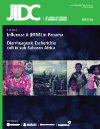Diarrheagenic Escherichia coli in sub-Saharan Africa: Status, Uncertainties and Necessities
DOI:
https://doi.org/10.3855/jidc.586Keywords:
Diarrhea, diarrheagenic E. coli, Escherichia coli, Enteropathogenic E. Coli, enterotoxigenic E. coli, enteroinvasive E. coli, enteroaggregative E. coli, diffusely adherent E. coli, Cell-detaching E. coli, antimicrobial resistance, Africa.Abstract
Diarrhea is a leading cause of illness and death, particularly in developing countries. Enteropathogenic Escherichia coli, enterotoxigenic E. coli (ETEC), enteroinvasive E. coli, enterohemorrhaghic E. coli (EHEC), enteroaggregative E. coli (EAEC) and diffusely adherent E. coli (DAEC) have been associated with diarrheal disease in different parts of Africa, particularly among young children, HIV-positive individuals, and visitors from abroad. Each of these E. coli pathotypes uses distinct mechanisms, which are only partially understood, to colonize infected hosts and produce diarrhea. All known diarrheagenic E. coli pathotypes have been reported from diverse locations within Africa but the true burden from these pathogens is unknown because very few studies seeking these organisms with discriminatory methodology have been performed. Recent reports implicate ETEC and EAEC in a considerable proportion of childhood and travellers' diarrheas and suggest that some sub-types of these categories may have greater epidemiological significance than others. The significant contribution of EHEC to bloody diarrhea and hemolytic uremic syndrome is underappreciated because diagnostic capacity for this pathotype is generally inferior to that for confounders such as Shigella and Entamoeba. Recent studies in Africa have revealed the worrisome emergence of antimicrobial resistance and high asymptomatic carriage rates for diarrheagenic E. coli but bacterial and host factors that predispose to disease, as well as non-human reservoirs, are largely unknown. Future diarrheal disease research needs to focus on broadening the repertoire of pathogens sought in epidemiological surveys to include multiple categories of diarrheagenic E. coli while building capacity to detect these pathogens in local reference laboratories.
Downloads
Published
How to Cite
Issue
Section
License
Authors who publish with this journal agree to the following terms:
- Authors retain copyright and grant the journal right of first publication with the work simultaneously licensed under a Creative Commons Attribution License that allows others to share the work with an acknowledgement of the work's authorship and initial publication in this journal.
- Authors are able to enter into separate, additional contractual arrangements for the non-exclusive distribution of the journal's published version of the work (e.g., post it to an institutional repository or publish it in a book), with an acknowledgement of its initial publication in this journal.
- Authors are permitted and encouraged to post their work online (e.g., in institutional repositories or on their website) prior to and during the submission process, as it can lead to productive exchanges, as well as earlier and greater citation of published work (See The Effect of Open Access).








